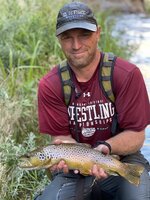As I enter my 40's I have been pondering trying to target bigger trout. Its something the whole family can enjoy. I have been fishing for 30 plus years, mostly rivers, and have caught maybe a handful of nice trout. Now I can fish a river/stream and catch 30-40 fish in a few hours. I know how to read water and make good cast but truly big fish have eluded me. Now I know the 1st thing is to fish waters that carry big fish which I do, 2nd spend lots of time on the water which I dont do. I probably fish a total of 5-10 days a year. Most of the time I would rather be hunting. But for some reason I can big trout on my mind, so I had a few questions.
1. if fishing from a river what tackle are you using to target big fish (5-10 pound browns/rainbows)
2. Fishing from the shore what tackle are you using
3. From a boat what tackle.
I have spots that have produced 5-20 pound browns but from me I have never been able to figure out how to tackle these fish. I mostly spend my time behind small lures on rivers (mepps, blue fox, panther martins) and catch a ton fish.
Thanks for the advice....
Probably going to be different everywhere but here in Colorado fly fishing tailwaters in the middle of the winter using the smallest midges you can size 22-24 and running them as deep as you can will get you the biggest trout.

